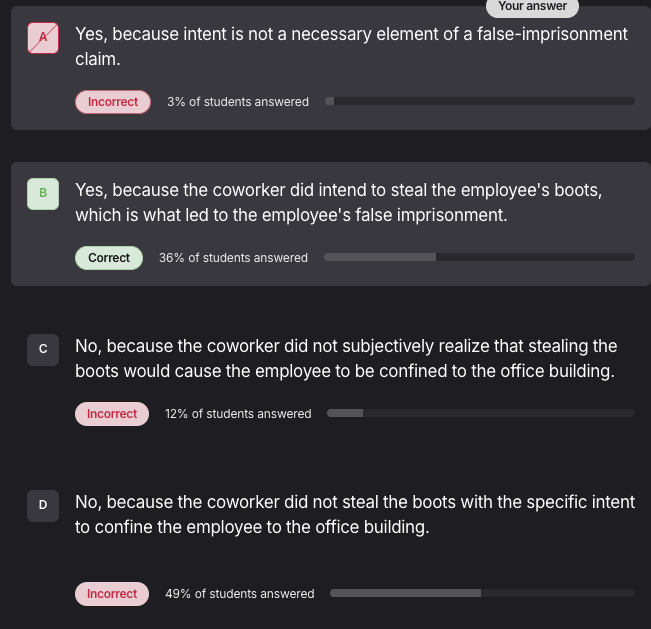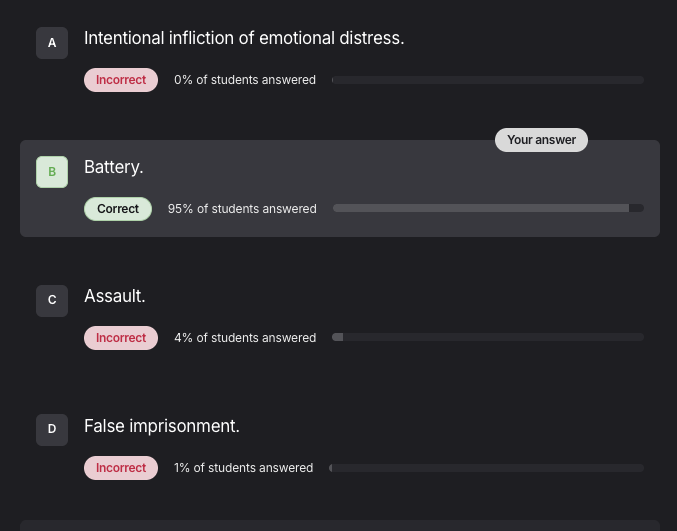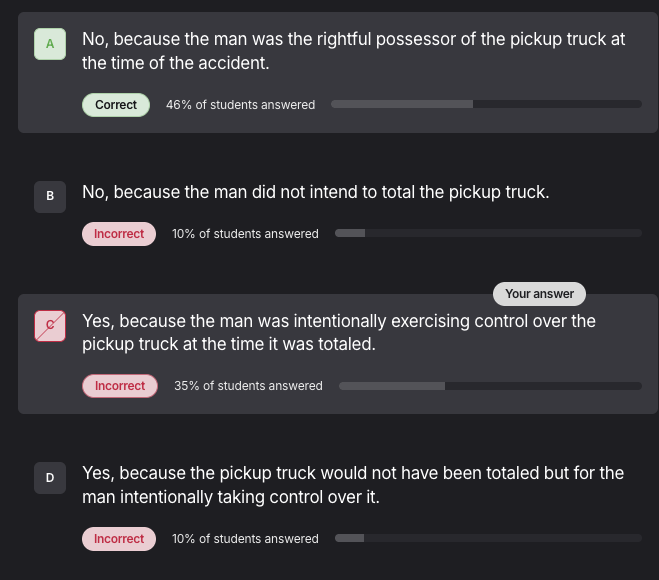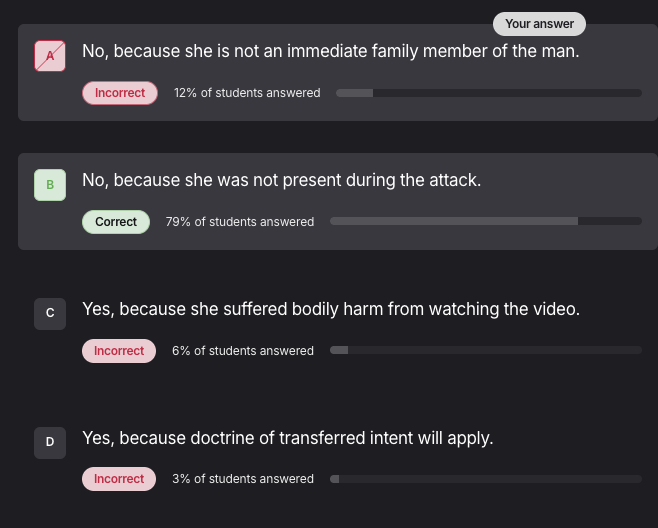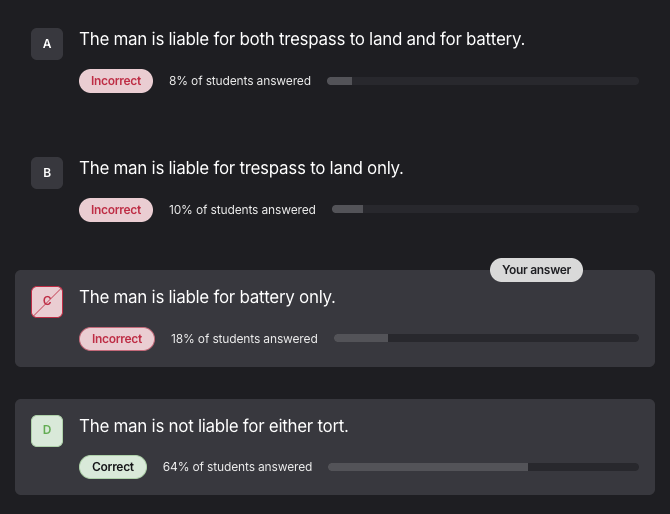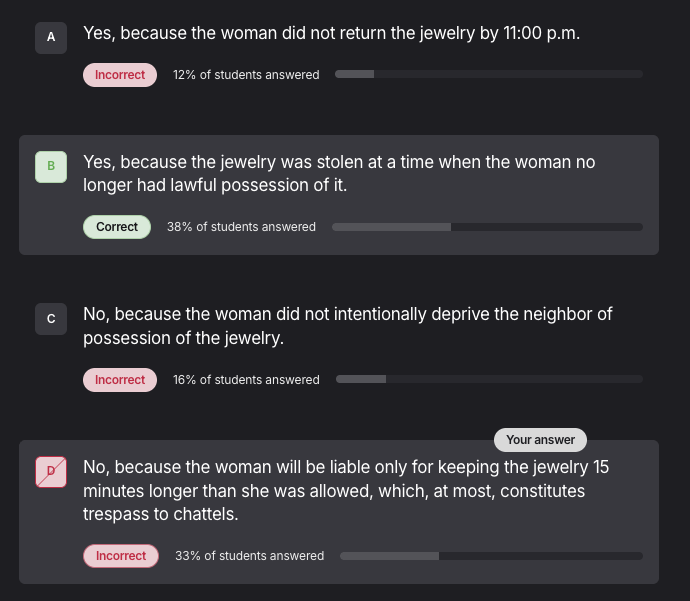Today I took a MCQ test on Intentional Torts. That covers:
- Assault and Battery
- False Imprisonment
- Intentional Infliction of Emotional Distress
- Defenses to Intentional Torts
- Trespass to Land, Trespass to Chattel, and Conversion of Chattel
I got 15/21 right.
Some questions I either found hard, but got right, or just got wrong:
Question 6: Got this wrong
An employee came to work wearing snow boots because a snowstorm was forecast to begin that afternoon. In the office, the employee changed into four-inch high-heeled shoes. The employee’s coworker was unaware of the forecast. The coworker came to work wearing high heels and without any snow boots. Later that day, the snowstorm began as predicted. When the coworker was ready to leave work, she snuck into the employee’s office and stole the employee’s boots. The employee worked late that night, and it was only when she was ready to leave that she discovered that her boots were missing. By then, the snow was so deep and the ground was so slippery that it would have been dangerous, if not impossible, to walk to the train station in high heels. Further, due to the snowstorm, there were no taxis or other ride options available. As a result, the employee had to spend the entire night in the office. Days later, the employee caught the coworker returning the boots to the employee’s office. The employee sued the coworker for the tort of false imprisonment. The coworker admitted that she had committed the tort of trespass to chattels when she stole the employee’s boots. However, the coworker argued that she could not be found liable for the tort of false imprisonment because she had never intended to confine the employee to the office building and had not even known that stealing the boots would cause that confinement.
Is it possible for the employee to prove all the elements of a false-imprisonment claim?
Answers and Explanations
Answers:
So false imprisonment, as I was doing this, meant intending to do something to cause false imprisonment. The lectures gave an example: you meet a girl at a resort, go to your hotel room, as your showering she takes your car keys and hides your pants, and then leaves. The false imprisonment comes from hiding your pants because people don’t want to go out sem-naked in a towel. Thats the false imprisonment.
Because this scenario kind of felt like that I assumed there was no intent element needed. To me this felt like false imprisonment, but I wasn’t fitting my understanding of intent about it. So I just kinda went with no intent.
Oh this is good. The videos didn’t cover this well (I wonder if coverage gaps are there because they expect you to learn stuff in law school classes?), from the answer explanation:
Answer option B is correct. The tort of false imprisonment requires: an act that is intended to, and that does in fact, cause the victim to be confined nonconsensually within a fixed set of boundaries of the actor’s choosing for any appreciable length of time. Further, the victim must either be aware of the confinement or be harmed by it, and the actor must confine the victim without any lawful authority to do so. Under the doctrine of transferred intent, if an actor acted with the intent to cause any one of five intentional torts (battery, assault, false imprisonment, trespass to land, or trespass to chattels), but the action results in the occurrence of another one of those torts, then the actor’s intent may be deemed to have transferred from the target tort to the actual tort.
Question 8: Got this wrong
A man had a vicious argument with his roommate about paying the next month’s rent. During this argument, the man threatened to kill the roommate if the roommate didn’t pay his share the next month. The roommate was terrified by this threat. Accordingly, when the man turned his back, the roommate picked up a statue, which was a valuable antique that belonged to the man. To protect himself, the roommate then attempted to hit the man on the head with the statue. As the roommate swung the statue at the man’s head, the statue fell apart. The man turned around and realized that the roommate had tried to attack him and that his statue was destroyed. The man sued the roommate for both assault and conversion.
What is the likely outcome of this suit?
Answers and Explanations
Ok. Without looking at the explanation just yet, I think I got this wrong due to sloppy reading. The man filed for assault and conversion charges. Yeah, no. Assault, more or less, is when you think battery will happen to you. The man didn’t think battery was going to happen to him, it just did. He has a battery charge, not an assault charge. I think I took assault as battery when I first read this.
So I was kinda right, from the explanation:
For the assault claim, one of the elements is that the victim was subjectively aware of the actor’s threatening, physical act. The man will not be able to prove this element because, at the time the roommate swung the statue at his head, the man’s back was turned. Therefore, the man was not subjectively aware of the threat that the roommate posed to him. Even if the man was startled or upset after discovering that the roommate had tried to hit him, by that point, the statue had already fallen apart and was no longer a threat. Because the man was not aware of any imminent threat as it was happening, he cannot prove the elements needed to establish an assault claim.
What an odd hypothetical. The statue just fell apart? I guess that’s possible. In my head I’m imagining fell apart as disintegrated which makes no sense.
Question 11: Got this right, but was confused about the scenario/hypothetical.
A private security guard at an art museum noticed that a patron had drifted too close to a sculpture. Approaching the patron from behind, the security guard grabbed the patron by the back of the arm and pulled her away from the sculpture. The patron drew her arm back out of the guard’s grip and shouted, “Don’t touch me!”
For which of the following intentional torts is the guard most likely to be held liable?
Answers and Explanations
This one I got right. It was more so why this is a valid hypothetical that confused me. I just kinda assumed a security guard had a right to grab patron. Maybe its because the patron drifted too close to a sculpture, but wasn’t touching it? Maybe if they were touching it the procedure should’ve been to talk to them before escalating to any kind of physical tough? Idk. The answer explanation doesn’t cover anything about that.
Question 13: Got this wrong.
A man’s neighbor loaned the man a pickup truck so that the man could deliver a sofa to his daughter. While en route to his daughter’s home, the man negligently ran a red light, causing an accident that totaled the pickup truck. The neighbor sued the man for conversion.
Is the neighbor likely to prevail in this action?
Answers and Explanations
So the man, borrowing his neighbors truck, got into an accident, which was his fault, with the neighbors truck.
I said Yes its conversion because he “did” something that change the car very significantly and it wasn’t his car.
The answer was No, because he was a rightful possessor. I do remember an element of conversion being something like you don’t have permission to use it. I also remember something like you have permission to do X, but not Y. This seems like a case of X, but not Y (though my answer doesn’t cover that). He was allowed to use it for the sofa, not to crash it.
Answer option A is correct. A person may be found liable for conversion of chattels when he or she (1) intentionally exercises dominion or control over the personal property of another, and (2) this dominion or control so seriously interferes with the right of the true owner or rightful possessor to control the property that the person may justly be required to pay the other the full value of the property. A defendant cannot be liable for conversion where the defendant himself had rightful possession of the chattel. Here, the neighbor loaned the pickup truck to the man, so the man was the rightful possessor of the truck as long as he was acting within the scope of the neighbor’s grant of permission, which he was at the time of the accident. The rightful possessor cannot interfere with his own rights by exercising dominion and control over the chattel. Answer option B is incorrect because the intent element of the tort of conversion does not require that the defendant intend any particular harm to the plaintiff. Answer options C and D are incorrect because, regardless of the circumstances under which the truck was totaled, the man was the rightful possessor of the truck at the time of the accident. Note that the neighbor may have a successful cause of action against the man for negligence but may not prevail on a conversion claim.
Oh ok. I thought I remember something about accidents not counting as something you’re permitted to do. Oh, from my notes on Conversion of Chattel:
-
Take a car crash:
-
If the borrower had permission to borrow the car then the crash (that was his fault in this context) is not conversion of chattel. Though damages from negligence may be awarded.
-
If the car was stolen and then crashed, then a conversion of chattel does apply (among other crimes).
Question 15: Got this wrong.
A criminal brutally attacked and beat a man, inflicting severe injuries. The beating was captured on security footage. The next day, the man’s girlfriend, who was not present when the man was attacked, viewed the security footage. The girlfriend experienced severe emotional distress resulting in bodily harm due to watching the video.
If the girlfriend sues the criminal for intentional infliction of emotional distress, is she likely to succeed?
Answers and Explanations
So I already looked at the explanation before writing why I think I got this wrong, but my initial thoughts were an issue of order. In my head I got the order wrong and this was a “choose the best answer” type of question. I assumed that B was right because you need to be present at the attack and then we need to take into considerations such as whether you’re a family member or not. Explanation:
Answer option B is correct. When a defendant acts directly upon one individual, causing emotional distress in a second individual, the second individual can only recover if she was present at the scene of the defendant’s commission of the tort against the first individual. Restatement (Second) of Torts § 46 cmt. l (1965) (noting that cases have limited “liability to plaintiffs who were present at the time, as distinguished from those who discover later what has occurred. The limitation may be justified by the practical necessity of drawing the line somewhere.”).
Here, because the man’s girlfriend was not present on the scene when the man was attacked, she will not be able to recover from the criminal for intentional infliction of emotional distress.
Answer option A is incorrect because recovery for intentional infliction of emotional distress is not limited to immediate family members. Non-immediate family members, however, will generally have to show bodily harm resulting from the emotional distress. Immediate family members will not have to prove bodily harm when the defendant knew of their presence at the scene and their relationship with the primary victim.
Question 18: Got this wrong.
A man was paddling a canoe on a lake when the canoe sprung a leak. The man realized that the canoe would soon sink if he did not get it to safety. The man steered the canoe toward the nearest land, a privately owned beach. When the man was in very shallow water near the beach, he got out of the canoe and started dragging it onto the land. A woman exited the house on the land and told the man that he was on her private property and could not take his canoe onto her beach. The man explained to the woman that his canoe had sprung a leak and that he needed to temporarily move it onto the beach to prevent it from sinking. The woman told the man that she did not care and did not give him permission to be on her property. The woman attempted to block the man from entering the beach. The man used reasonable and proportional force to stop the woman from expelling him and his canoe from her property. The man did not cause any actual damage to the woman or the woman’s property by landing his canoe on her beach. The woman later sued the man for trespass to land and for battery.
How will a court likely rule on the man’s liability for each tort?
Answers and Explanations
So I remember there being an exception kind of thing for emergencies. So I knew he could come on the land. I didn’t think that meant that the person couldn’t defend their property, which is what I assumed the women was doing here. Or maybe the women was allowed to defend her property (block him), the man was allowed to use proportional force to stay on the property (given the circumstances), and both just kind of cancel out (I assume the women isn’t held liable for blocking him).
Answer option D is correct. A party who commits trespass to land has a valid defense of private necessity if it is necessary for the defendant to be on the plaintiff’s land in order to prevent serious harm to the defendant himself, or to the defendant’s real or personal property. Restatement (Second) of Torts § 197 (1965). Where the defense of private necessity exists, the defendant has an overriding privilege to be on the property without the plaintiff’s permission. Therefore, the plaintiff has no authority to expel the defendant from the premises.
Here, the man will be able to assert a valid defense of private necessity to the tort of trespass to land. The man’s decision to land his canoe on the woman’s beach was necessary in order to prevent his canoe from sinking. Because the man did no actual damage to the woman’s land, the man will not be liable for trespass to land. Additionally, because the man was privileged to be on the woman’s land due to private necessity, the woman did not have the right to attempt to expel the man or his canoe from her property. By attempting to block the man’s entrance, the woman acted as the initial aggressor, and the man was entitled to use reasonable and proportional force to stop the woman from preventing him from entering her property. Id. at §§ 63, 197 cmt. k. Therefore, the man has acted in self-defense and will not be liable for battery on the woman. Answer options A, B, and C are necessarily incorrect for the reasons stated.
Ok, so the women was not allowed to expel. I wonder whether she can therefore be hold liable for battery from blocking him?
Question 21: Got this wrong.
A woman borrowed jewelry from her neighbor to wear to a fancy party. The neighbor told the woman that the woman had to return the jewelry to the neighbor by 11:00 p.m. that night. The party went later than the woman expected. At 11:15 p.m., the woman was walking home from the party, planning on returning the jewelry to her neighbor. When the woman was only one block away from the neighbor’s house, a mugger attacked her and stole the jewelry. The neighbor later sued the woman for conversion.
Is the court likely to find that the woman committed the tort of conversion?
Answers and Explanations
Ok. So conversion requires illegal possession/use, some kind of really significant change (conversion) that interferes with the right of the true user. So I guess the illegal possession is important here? So if something is stolen from you (the lady having her jewelry past the time can be considered stealing ig) and then the thief gets the item stolen, then the first thief is liable for conversion? Why? Lets see: because if not for their actions the conversion would have not happened? Or maybe, the view is they played a part in the conversion? How so? Her illegal holding of it (which probably would have just been trespass) turned into a conversion because now the true owners rights are being interfered with. Explanation:
Answer option B is correct. A defendant commits the tort of conversion when she intentionally exercises near-total, owner-type dominion over personal property, coupled with a resulting serious interference with the rights of the true owner or other rightful possessor. Restatement (Second) of Torts § 222A (1965). A party commits conversion if the owner’s property is lost, destroyed, or otherwise seriously interfered with at a time when the defendant did not have the right to lawfully possess it.
Here, the woman was in lawful possession of the neighbor’s jewelry until 11:00 p.m. that night. After that time, she was no longer in lawful possession and was therefore liable for conversion for the loss or destruction of the jewelry, even without any fault on her own behalf. Therefore, when the woman was mugged, a conversion of the neighbor’s jewelry occurred, even though the loss was entirely due to the fault of a third party.
